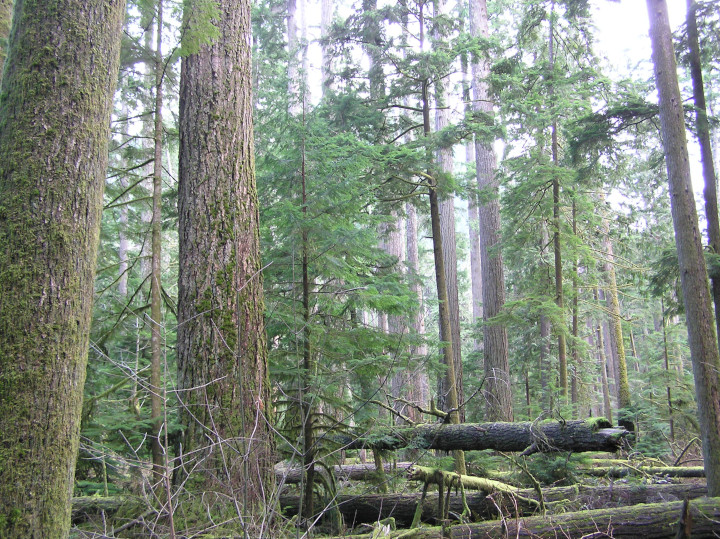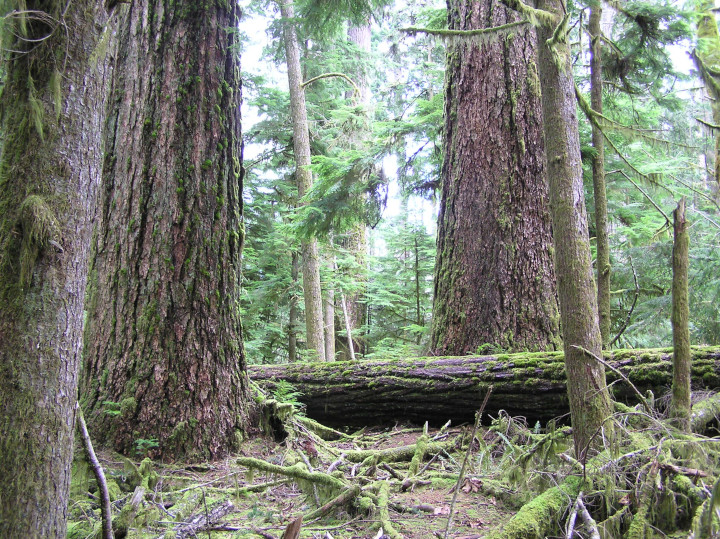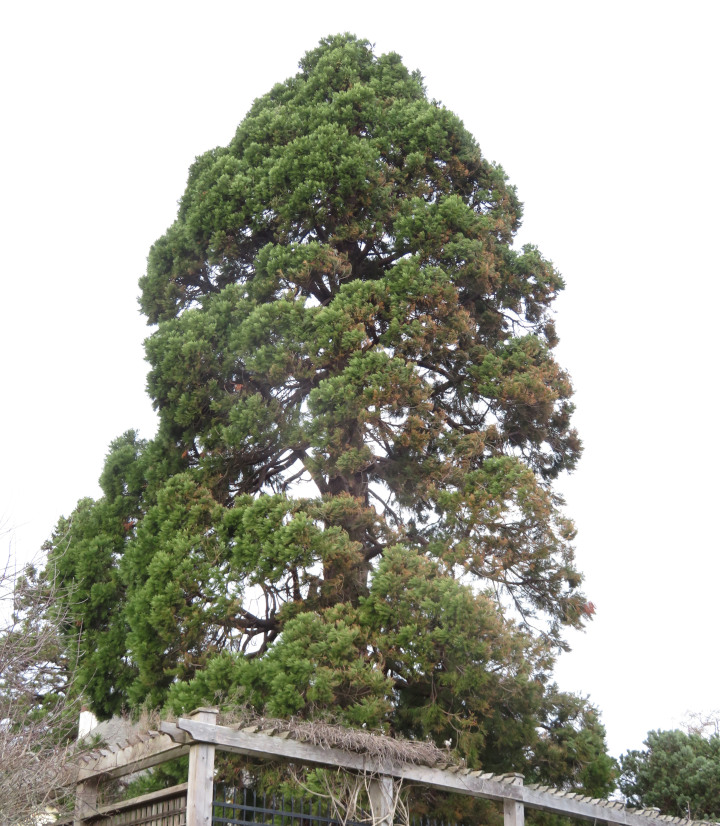
Nature, science, language, values, feral beliefs...
Entries for December 2023

Mistaking the Forest for the Trees
Last week I mentioned that simplified (impoverished) language misrepresents nature. This misrepresentation leads to poor decisions. For example, when we talk about forests, if we focus our descriptions simply on the living trees (which often happens in the context of timber, carbon storage, scenery, recreational opportunities, and many other human uses) the crucial role of dead, dying and decaying wood becomes minimized in our minds. People even start using phrases like like "decadent trees are unproductive", or "dead trees are an eyesore", or lately, "dead wood is a fire hazard". The idea that forests can be “tidied up” to remove dead wood (yet still remain forests) is the unfortunate consequence of this language.
Dead and dying still-standing trees, and horizontal logs - sometimes called Coarse Woody Habitat - are a major component of [unmanipulated] forests. In addition to all the activity of microorganisms and invertebrates, Coarse Woody Habitat provides shelter and foraging opportunities for many birds, mammals, amphibians and reptiles. Many of these organisms require different stages in the decay process to survive. Mammals that use dead and dying trees for shelter range in size from bears to mice and shrews. Woodpeckers excavate cavities in large standing dead trees that many other bird species take advantage of for nesting and roosting. Loose, decaying bark still clinging to dead trees can provide roosting sites for species of small birds and bats.
If you walk into a forest and look around, unless you know what to look for, you probably won't notice much evidence of all the processes that are going on. All the microorganisms are invisible, but even larger creatures living in and under the logs, branches and organic matter will mostly remain hidden. You won't see all the fungal [mycelia] spreading throughout the forest floor, nor even many of a wide variety of mushrooms unless it happens to be the right time of year. There might only be a squirrel or a few birds nearby during your tiny time slice glimpse of the long series of processes that a forest is.
If they think about forests at all, most people focus on lots of trees. Our use of language tends to channel us into thinking about trees and forests as "things". All of the living processes that very gradually result in the formation and maintenance of forest soil activities are rarely considered. "Things" are conceived to be removable or replaceable objects, and are relatively simple. This is not just about forests. Nature is not really made up of things.

Trees Falling in the Forest
We are at a point where a significant
portion of the population misunderstands important
emerging issues, just as reality becomes increasingly
complicated. (Huge numbers of humans will apparently
do a number on a planet.) One global issue we are all
struggling to understand is to what extent climate
change can be mitigated by “nature restoration". In
this context, some people call for the planting of
trillions of "trees". They call this "forest
restoration".
A lot of "trees" planted in an area don't make a forest, and this common type of linguistic subterfuge can cause misunderstanding and warp minds. Of course, there are many different types of forests, and they all do have a lot of trees, but that is far from everything that a forest is. There are some obvious differences between forests and plantations: forests include trees of all ages, from saplings to old growth; a number of different tree species live mixed in forests and the composition varies over time; forests have very irregular spacing of living trees, and necessarily include dead, dying, and decayed remnants. In the long process of dying and decaying, tree remains create important ecological effects that can persist for more than a century. All of the structural and temporal irregularities of tree growth and death affect other plant and animal populations that co-exist in a forest.
Theoretically, a plantation might very gradually evolve into a forest if planted properly over time with a mix of species and very uneven spacing - but that process would take many human lifetimes. Just what sort of future climate such a forest might face by then is a serious question. Since we can't plant a forest, the most beneficial course of action seems to be to preserve the world's remaining forests. That course of action would obviously conflict with opposing vested human financial interests - interests that might welcome the term "forest restoration" and all that it implies and ignores.
While planting trees can make sense as a response to some human goals - providing more livable cities and pleasant landscaping - human goals are inappropriate for thinking about forests. Anthropocentrism looks like it is leading us to a very unpleasant future.
A lot of "trees" planted in an area don't make a forest, and this common type of linguistic subterfuge can cause misunderstanding and warp minds. Of course, there are many different types of forests, and they all do have a lot of trees, but that is far from everything that a forest is. There are some obvious differences between forests and plantations: forests include trees of all ages, from saplings to old growth; a number of different tree species live mixed in forests and the composition varies over time; forests have very irregular spacing of living trees, and necessarily include dead, dying, and decayed remnants. In the long process of dying and decaying, tree remains create important ecological effects that can persist for more than a century. All of the structural and temporal irregularities of tree growth and death affect other plant and animal populations that co-exist in a forest.
Theoretically, a plantation might very gradually evolve into a forest if planted properly over time with a mix of species and very uneven spacing - but that process would take many human lifetimes. Just what sort of future climate such a forest might face by then is a serious question. Since we can't plant a forest, the most beneficial course of action seems to be to preserve the world's remaining forests. That course of action would obviously conflict with opposing vested human financial interests - interests that might welcome the term "forest restoration" and all that it implies and ignores.
While planting trees can make sense as a response to some human goals - providing more livable cities and pleasant landscaping - human goals are inappropriate for thinking about forests. Anthropocentrism looks like it is leading us to a very unpleasant future.

Go Big and Go Home
I started writing these short posts after becoming bemused by the surprising (to me) number of Sequoia giganteum (giant sequoia) that have been planted around the city of Victoria, B.C. in the last hundred years or so. After weeks of searching, and then locating them on a map, and the many months since, I'm not at all sure what to think about the presence of these iconic trees in an urban setting. Are they "out of place"? And how can they even survive in such an unnatural setting? For days at a time, I don't think about them at all... This is not one of those days.
Except for those growing in parks and on golf courses, the giant sequoias around Victoria have largely been planted in people's yards. Understandably, they have not been used by city planners as street trees. Although the conjured image of a street lined with towering, 150-year-old giant sequoias would be...something...to see, that's surely best left in the realm of the imaginary. Whatever purposes the trees help fulfill growing in people's yards probably varies over time as they become ever larger. Their size was appropriate for the scale of their prehistoric natural forest habitats, which for many millions of years never experienced cities. Their evolved characteristics also obviously formed in the absence of any environmental changes introduced by human activity. Where they were, and how they came to be there long before humans stumbled upon them, could make a fascinating study.
While a solitary majestic sequoia tree towering over a house on a city lot might seem somewhat incongruous, it also stands out as a potential reminder of nature's remarkable complexity. (Those with an appetite for irony might get an additional kick out of the symbolism, but that's a different topic.) Well, such a massive tree's presence could be a reminder if people noticed. For the most part, passersby seem unimpressed or unaware. In the Pacific Northwest of North America there are so many "trees". Some are big. Some are small. Many people seem to learn the term "tree" and that's mostly enough for daily thinking. It's not of particular interest that a tree species has existed for over 200 million years, like the Ginko - which is planted as a street tree in Victoria and other cities. And really, what can you say about a giant sequoia that could live for several thousand more years planted on a city lot that has only existed for a century?
The giant sequoias, as landscape features in a yard, seem to create a conundrum: their potential size may be an attraction, but before ever attaining a mature size, they would get too large to be suitable for the urban environment. Hmm... Mature giant sequoias are very brittle, and shatter when they fall, which historically made them unsuitable for lumber production - thus, giant trees were sometimes made into matchsticks! In retrospect, that doesn't even seem surprising. On the other hand, apparently the negative public reaction to reducing majestic trees to matchsticks resulted in the creation of protected reserves where they couldn't be cut down. On the other, other hand, maybe it's best not to hope that people will do the right thing after they have exhausted all the other possibilities.

Misunderstanding Misunderstanding
The problem is not just that "Artificial Intelligence" (AI) isn't what its promoters claim - more concerning is the fact that it now exists and is so promoted. It is fine to point out, as numerous people have, that computers cannot really "know", or "learn", or "understand" anything, but that shouldn't even be necessary. Learning and understanding are parts of a continuing process that living, embodied creatures engage in as they develop. The result of "AI" informing human thought is likely to be "Artificial Understanding" (another oxymoron).
The damage from this confusion has been done. The general public cannot tell the difference between statistical associations of words programed and stored in a computer database, and actual knowledge that creatures derive through experience. Computers are not alive and don't experience anything - instead they are programmed to compute relationships in ways that give results that seem to be acceptable for a defined purpose. Words and concepts missing from computer "training" databases will produce gaps and errors in program output. More extensive training will not overcome the programs' dependency on text and imagery that already exists. (Please do not think that all human thought is merely recombination of previous thought.)
With so much misunderstanding generated by the high-tech push for an "AI" saturated future, the prospects for increased appreciation for Nature and natural processes look dim. Are we facing a potential offer of "Artificial Nature" sometime soon? There may be tasks that "AI" systems can accomplish more quickly and efficiently than humans. Such cases will undoubtedly be touted as great accomplishments that humanity should not go without. Is there prior history that might reassure us that the use of those systems would only be ethical and beneficial? Not really. The danger is that some of those tasks seem likely to involve accelerated degradation of our remaining natural surroundings. That might include the effects of military use of "AI" in current and future warfare.